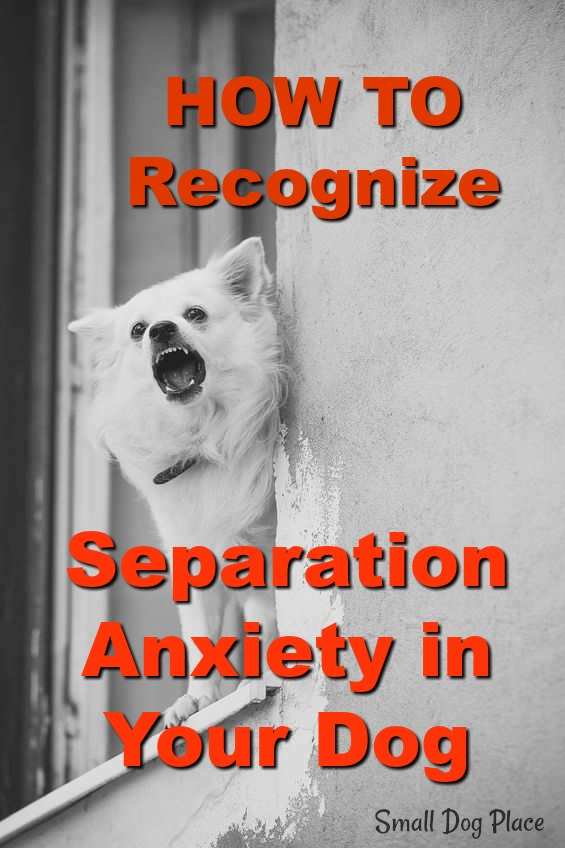- Small Dog Place Home
- Emotional Problems
- Separation Anxiety in Dogs
What is Separation Anxiety in Dogs?
by Emily Folk
Separation anxiety in dogs is especially common in small/toy breeds, but experienced by any size and breed of dog. Studies indicate about 30 percent of dogs experience some form of separation anxiety during their lives.
It’s an anxiety disorder, and is defined as "a state of intense panic brought on by the dog’s isolation/separation from its owners.”
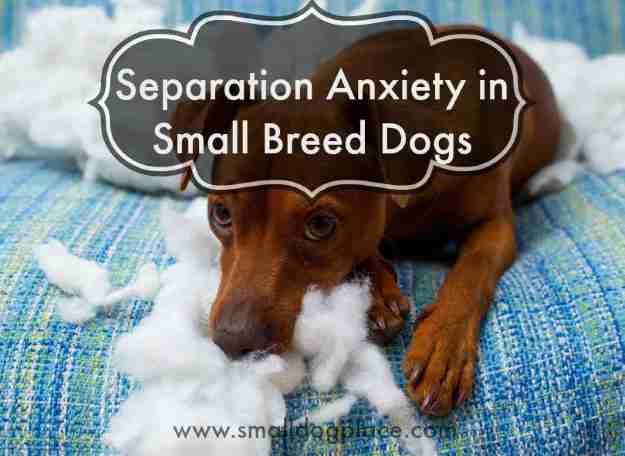 Separation Anxiety in Small Dog Breeds
Separation Anxiety in Small Dog BreedsIn other words, your dog is thrown into a state of nervous anxiety whenever you leave the house, rather like a canine panic attack, typically within minutes of your departure.
As the anxiety escalates, a wide range of behaviors emerge. According to Rebecca J Sargisson, dogs will display many different types of unwanted behaviors.
- Barking and howling without triggers
- Whining
- Excessive panting
- Pacing
- Potty accidents
- Destructive behaviors
Some dogs exhibit these behaviors as the owner prepares to leave, while others exhibit anxiety after the owner leaves. Dogs are very clever at picking up on our routines and rituals and can predict when we will leave.
Why does this happen?
Well, for one thing, dogs are social animals, just as humans and they need lots of company and social interaction to keep them happy stimulated, and content.
No dog likes to be left alone for long periods of time, but some dogs do a lot worse than others. Boredom often accompanies the anxiety.
Separation Anxiety in Dogs: Risk Factors
- Any breed or dog can develop this disorder at any point in their life
- Shelter Dogs who have suffered multiple traumas and abandonment
- Puppies who were separated too early from their mother
- Dogs left alone for long periods of time
- Dogs that experienced something traumatic while home alone such as a severe thunderstorm, hail storm or other severe weather event.
- Sudden change in routine such as a stay at home owner taking on a job away from the home or even a vacation trip
- Owners making a fuss when leaving home or coming home. This increases excitement in the dog and signals a big change, which can manifest as anxiety.
Causes of Separation Anxiety in Dogs
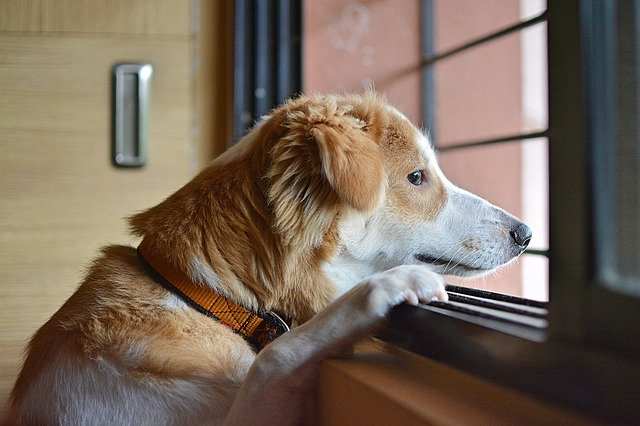 Many different factors can cause separation anxiety in dogs.
Many different factors can cause separation anxiety in dogs.The evidence about
what causes separation anxiety is inconclusive, but researchers believe factors
such as genetics and early socialization play a role.
- Genetics
- Early Trauma
- Abandonment
- Long Periods of Separation
- Big Changes
- Cognitive Decline (in older Dogs)
Genetics Plays a Role
Some breeds are genetically predisposed toward anxiety and insecurity, which is something you should consider when deciding which breed you’re going to go for (particularly if you’re going to be absent for long stretches of time).
Even within a breed are those individuals who tend to be hyper-vigilant, even if their owners are with them. These are the dogs that are always running to the door or window or nervously follow their owners around the house.
Many of the hunting breeds are prone to anxiety, such as the German shorthaired pointer or small dogs such as a toy poodle.
Trauma
Any traumatic event can trigger separation anxiety in dogs or anxiety in general.
Dogs are unable to process natural disasters the way we are and cannot assess future risk. A house fire, tornado or flooding may leave your dog restless and fearful for years to come in any situation remotely similar, such as a thunderstorm passing through.
Abandonment
 Trauma, Abandonment, Genetics, Cognitive Decline and Big Changes in a dog's life are some of the causes of separation anxiety in dogs.
Trauma, Abandonment, Genetics, Cognitive Decline and Big Changes in a dog's life are some of the causes of separation anxiety in dogs.Dogs
that are abandoned
at the shelter or given to a new owner may develop separation
anxiety.
It’s difficult to say whether the trauma of being in a noisy shelter with other animals and less attention triggers the anxiety or the loss of the dog’s family causes the anxiety.
Long Periods of Separation
Your dog craves and needs your company, affection and attention in order to be happy and content. Canines are pack animals and don’t typically enjoy being alone.
However, you may work an outside job and it’s necessary to leave your dog for long periods during the day. Consider having a dog walker come in a couple of times a week to give your dog company and exercise, or run home on a lunch hour when possible.
Cognitive Decline
Some dogs that have never experienced separation anxiety may become tense and panic when their owners leave. In older dogs, this may be a sign of cognitive decline.
Older dogs sometimes have hearing or vision loss as well, which makes them feel uncertain even of familiar surroundings.
Big Changes
Experts believe any big change may trigger anxiety in dogs prone to the condition.
Big changes include a move to a new home, marriage and divorce, or children growing up and leaving home. Even things such as a new baby or the caregiver who has always been home getting an outside job may contribute.
Recognizing Separation Anxiety in Your Dog

You Know Your Dog Has Separation Anxiety, if...
You probably do not need to take your dog to a veterinarian or dog behavioral specialist to determine a diagnosis. There are tell-tale signs your dog is suffering and most owners will pick up on these behaviors.
First, your dog usually learns to tell when you’re about to leave because they are very good at picking up the cues you give off such as keys jingling and will see you putting on your coat.
They begin to feel anxious. They may follow you from room to room, whining, trembling and panting. Some dogs even become aggressive, in an attempt to stop their owners from leaving. Most simply grow worried, though.
When you have left, the anxious behavior continues. The best way to see how your dog reacts is to set up a camera and see how long after you leave the anxious behavior starts, what that behavior entails and how long it lasts. This varies widely from canine to canine.
They may bark or howl nonstop without an obvious trigger, or they may scratch and dig at windows and doors in their mistaken belief that they can get out and be with you.
They might also chew inappropriate items, and even urinate and defecate inside the house. In extreme cases, they might harm themselves by licking or chewing their skin until it is raw or pulling out their fur.
Some dogs will also engage in obsessive-compulsive behaviors, like spinning and tail-chasing. Before you can determine that your dog has separation anxiety, you should rule out the possibility of a medical problem.
Signs Your Dog Might Be Anxious
- Your dog follows you from room to room when they know it’s time for you to leave
- Your pet is excessively excited to see you when you return (he acts likes he hasn't seen you in years)
- Your dog engages in destructive behaviors when you are gone. (Chewing, Urinating, Tearing up fabrics, Digging, Trying to Escape)
- Your dog howls, cries, whines or barks while you are gone
- They pace or run in circles
- Your dog engages in self destructive behaviors--(chewing at paw)
- They defecate even though they’ve just gone before you left
- Your dog hides and pant with tongue hanging out when they see you preparing to leave
Upon your return, they’ll be excessively excited, and will leap around you in a state of delight for a long period of time, much more than the usual 30 seconds to one minute that is common in happy, well-adjusted dogs.
Some owners misunderstand this extended greeting. These owners do not understand that such a greeting actually signifies the presence of a psychological disorder (i.e. separation anxiety disorder).
Instead, these pet owners actually encourage their dog to get more and more worked up upon their return by fueling the dog’s excitement, encouraging your dog to leap around.
If you’re behaving in this way with your dog, please stop. I know it’s tempting and very easy to do, and it seems harmless. After all, she’s so happy to see you, what harm can it do to return the dog’s attention and affection in equal measure?
What is actually happening is that you are endorsing the belief that your return is the high point of the day. So the dog is happy when you return but, when it’s time for you to leave again, gets even unhappier when you walk out that door.
Fortunately, there are things you can do to help your anxious dog.
Tips for Easing Separation Anxiety in Dogs
- Leave chew toys, a couple of hard treats and a Kong Toy stuffed with something irresistible to your dog.
- Take your dog on a brisk walk before you leave.
- Turn on music--soft classical music calms some dogs.
- Some dogs do better in a room with a view (a window).
- Some dogs prefer a secure dark den (crate) – crate train from the beginning for best results and slowly increase the time your dog is in the crate. Feed them in the crate and place them in the crate while you are home.
- Leave a piece of your clothing. This leaves your scent with the dog and may provide comfort.
- Don't make departures or arrivals a big deal.
- Wait a few minutes after arriving before you greet the dog.
- Some over-the-counter calming agents may help.
- Use a word that tells the dog you'll be back and say it the last thing before you leave.
- Ask your veterinarian about drug therapy.
- Consider doggie daycare.
- Leave from different doors and place your keys and other items in different locations, so the dog doesn’t learn your patterns as easily.
- Take your dog to obedience training. A well-trained dog is more likely to feel as though there is a leadership structure in the home and be less anxious overall.
Helping Your Anxious Dog Deal with Separation Anxiety in Dogs
Exercise
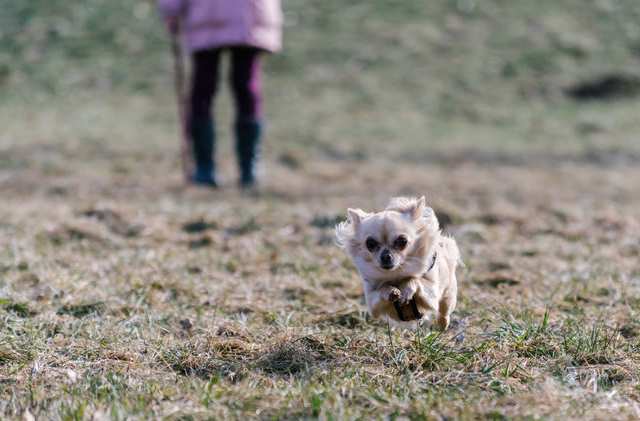 For dogs with Separation anxiety, exercise is a good way to help them calm down and rest while you're away.
For dogs with Separation anxiety, exercise is a good way to help them calm down and rest while you're away.Give your anxious dog plenty of opportunities for exercise. This is really important for larger dogs, but small dogs benefit from a short brisk walk, too. Remember, if you’re leaving for work in the morning, your dog will probably be alone for at least four hours.
If you have a dog-walker to take the dog out mid-day instead of coming back yourself, it won’t see you, the most important person in its life, for at least nine hours! So, your dog needs a good, vigorous walk (15 to 20 minutes is the absolute minimum here!) before you walk out that door.
More is even better. Exercise is essential for dogs with separation anxiety. A tired dog is less likely to engage in anxious behaviors. You know what they say.
~A Tired Dog is a Good Dog~
Chews, Toys, Kong Type Toys
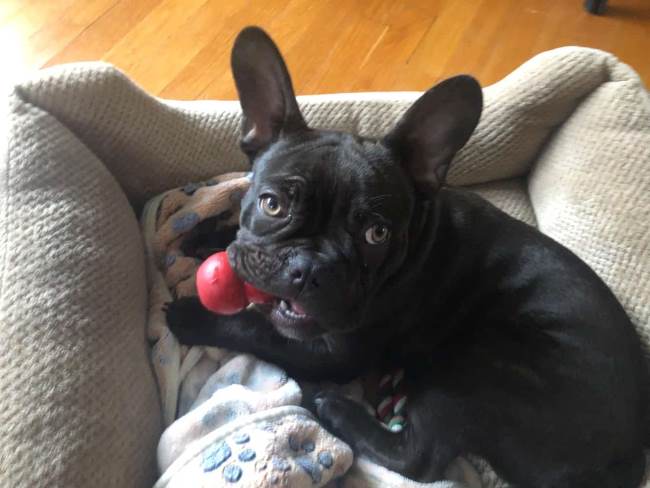
Distract
your dog from their boredom, loneliness and anxiety by giving them a substitute
for the anxious pacing and whining. All dogs love to chew — why not
play on this predisposition?
Get a couple of bones or toys and give them one about 5 minutes before you leave. Never leave your dog alone with anything that might create a choking hazard, however, so make sure the toy or bone is sturdy enough for anxious gnawing.
It’ll keep your dog happy and occupied, and will help ease the anxiety she feels when you leave. A Kong Toy is also a wonderful object to help anxious dogs.
Stuff the Kong Toy with something your dog loves such as peanut butter, cream cheese, cottage cheese, canned dog food, cheese or whatever your dog loves.
As you are walking out the door, give him the Kong. Take it away as soon as you return so that he begins to associate your leaving with his getting this special treat.
Quiet Music
When you leave, put the radio on to a soothing station: classical music is ideal, but any station featuring lots of talk shows is also ideal.
Keep the volume quite low and barely audible, and it’ll calm the dog down a bit and give them the feeling that they’ve got company.
You could also turn a television on and create the same type of background noise. Choose stations with soothing voices, such as the History Channel or Animal Planet.
Any soothing sounds will help with puppy separation anxiety. Have you checked out our article on using Music to Calm Your Anxious Dog?
A Room with a View
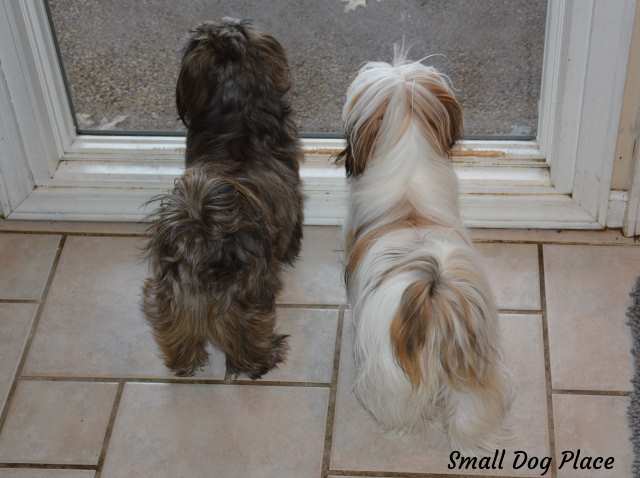 A room with a view may help some dogs with Separation Anxiety.
A room with a view may help some dogs with Separation Anxiety.Some dogs prefer to watch the world go by. If at all possible, supply your pooch with a view. If the dog can see the world going by, that’s the next best thing to being out and about in it.
Dogs with separation anxiety should not have the run of the house, but should not be confined to a crate either.
A good compromise is a small room or a section of a room partitioned off by an exercise pen. Make sure the area is free of anything the dog might harm itself on while you’re away.
If a window is available, the dog will not feel quite so isolated. Watch your dog's reaction, though, as sometimes a window can cause even more anxiety. If your anxious dog is prone to barking at everything he sees through the window, then a room without a view is the best choice.
Your Personal Departure Routine
Acclimatize your canine to your leaving through a conditioning process.
Pretend to get ready to leave, jingle your keys and put on your coat, and open the door. Then, turn around and sit back down.
Do this until the dog’s not reacting any more. When there’s no reaction, give them a treat and lavish praise for being so brave. Next, practice actually walking out the door, and returning immediately, again doing this until there’s no reaction.
Gradually work up until you’re able to leave the house with no signs of stress from the dog. Determine what you will say as you walk out the door and remember to say the same thing exactly the same way each time you leave. "I'll be back!"
Leave Something of Yourself
Leave a piece of your un-laundered clothing for your dog. Most dogs will drag it into his bed or cuddle up with it on the floor. Change it out each day. If you are worried about your dog chewing, choose an old T-Shirt that is bound for trash. Your dog will love you for it.
Calming Products
There are a number of calming products on the market, including chew tablets and comforting scents.
There are over the counter calming agents such as Comfort Zone with D.A.P. (Dog Appeasing Pheromone) or Sentry Calming Collar. Other products you simply spray on your pet’s bedding or plug a unit into a nearby outlet when you leave the house. Some companies offer drops you add to the pet’s food or water.
Some dogs respond to scents. The rationale behind these items is that they produce a synthetic form of a pheromone that mimics that of a lactating female and thus reduces anxiety.
Thundershirts work well with separation anxiety as well as thunderstorms for some dogs as well. These tight shirts act the same way as swaddling a newborn baby.
Medications
In more severe cases, your veterinarian may prescribe an anti-depressant or an anti-anxiety medication for your dog. Dr. Arielle Schoenlein, DVM, from Quakertown Veterinary Clinic, says that medication can be used to help with Separation anxiety in dogs. Medications used today do not make the dog sleepy. They do not interfere with learning and memory. A popular option for dogs is Prozac or fluoxetine.
Most experts recommend that medication be used in conjunction with other behavioral approaches to ease the symptoms of anxiety.
DON’Ts
for Dealing with Separation Anxiety
Are you guilty of any of these very human reactions to your dog's separation anxiety? If so, you're not alone, but they don't work.
Forget the Sympathy
Our first reaction is to become very sympathetic to her whines and cries, but this type of reaction is likely to backfire.
Although it sounds very cold-hearted, trying to soothe and comfort your dog by patting her and cooing over her is actually one of the worst things you can do. What this does is validate her feelings.
Forget the Punishments
Anxious behaviors are not the result of disobedience or spite, and harsh scoldings will make things worse. If you punish him, he may become even more upset and the problem could get worse.
Be patient, and
work with your pet even if it means taking baby steps until he feels comfortable and enjoys spending time away from you.
For severe cases, there are methods to desensitize dogs and counter-conditioning protocols that normally require the help of a professional.
If you feel your dog might be in this category, it would be best to consult a Board Certified Veterinary-Behavioralist or a Certified Applied Animal Behavioralist (CAAB or ACAAB).

Separation Anxiety in Small Dogs,
by Emily Folk
Author Bio:
Emily is an animal lover and sustainability blogger. To read more of her work, follow her blog, Conservation Folks, or follow her on Twitter.
Related Articles You Might Find Helpful
Stress in Dogs: Do You Have a Stressed Dog?
About Janice (author and voice behind this site)
Having lived with dogs and cats most of her life, Janice served as a veterinary technician for ten years in Maryland and twelve years as a Shih Tzu dog breeder in Ohio.
Her education includes undergraduate degrees in Psychology with a minor in biology, Early Childhood Education, and Nursing, and a master's in Mental Health Counseling.
She is a lifelong learner, a dog lover, and passionate about the welfare of animals. Her favorite breed for over 50 years has been the Shih Tzu, but she has also lived with Poodles, Maltese, Yorkshire Terriers, Beagles, English Bulldogs, Carin Terriers, and a Cocker Spaniel.
When not writing, reading, and researching dog-related topics, she likes to spend time with her eight Shih Tzu dogs, husband, and family, as well as knitting and crocheting. She is also the voice behind Miracle Shih Tzu and Smart-Knit-Crocheting
Does This Article Deserve Your Thumbs Up?
We always appreciate your support and encouragement. Your thumbs up means so much to us. Please like this article.
If you find this page or any page on Small Dog Place Helpful, or useful in anyway, I'd love it if you would click the small heart found on the bottom right of each page.
You can also share or bookmark this page -- just click on the:

Free Monthly Newsletter
Sign Up for Our Free Newsletter and get our Free Gift to You.
my E-book, The Top 10 Mistakes People Make When Choosing a Dog (and how to avoid them)
